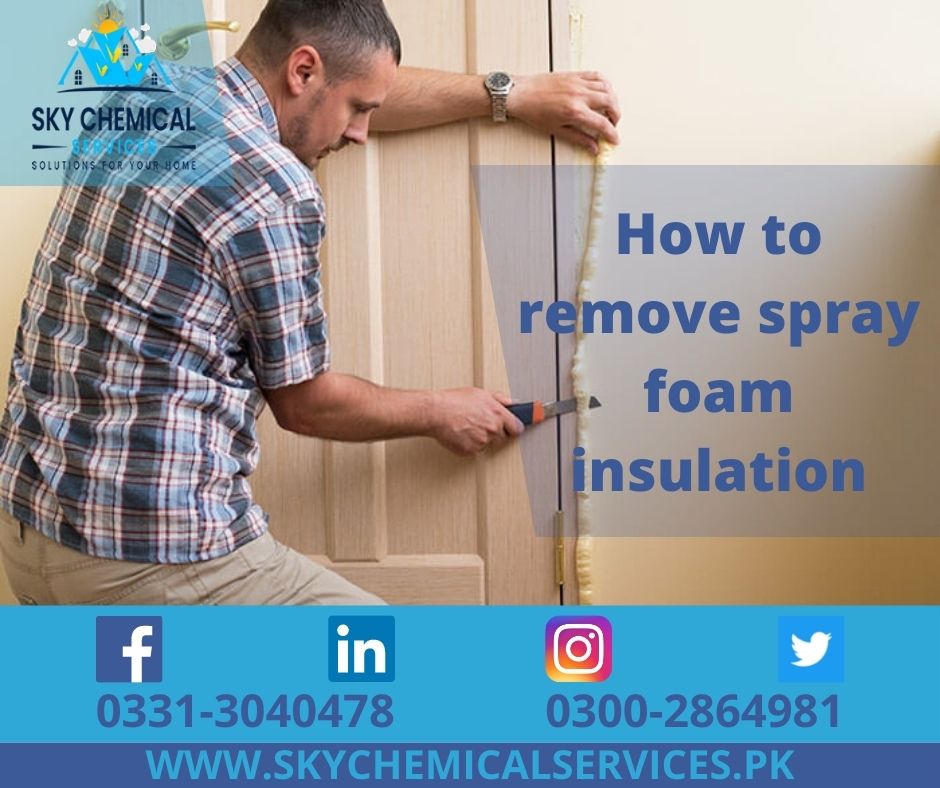
Most people do not have to bother about learning how to remove spray foam insulation. This is because they don’t require any sort of insulation for their homes or offices. Spray foam’s qualities make it a good insulator due to its impermeability, expandability, and long-term dependability.
When spray foam insulation is installed, it expands to establish tight seals, eliminate voids, and create an impenetrable barrier. We only use this type of insulation under strict conditions during installation. Our top aim is to keep you safe. During installation, we put up air ventilation systems and wear protective clothing and masks.
Steps to Remove Spray Foam Insulation
-
Manually
We’ve put together a quick explanation of the spray foam removal method for those who are interested. This is purely for educational purposes and is not meant to be a guide or a how-to. Before starting, check for electrical cables, piping, or pipes beneath the insulation you’re about to remove.
With regards to safety, put on a mask and other protective gear. Cut insulation with a knife or any other tool that will accomplish the job, such as a saw, a crowbar, or a claw hammer. Lastly, remove the insulation from the areas where it was previously installed. Repeat steps 2 and 3 until the insulation has been taken away completely. With a flathead screwdriver, paint scraper, or similar instrument, scrape away any leftover insulating residue. Remove any remains that you can’t ply or scrape away with lacquer thinner.
Don’t use water on the foam as this will cause it to cure and become harder. Also, do not use heat on the insulation in an attempt to melt or burn it away.
-
Machine Removal
Manually removing the foam is an arduous task and takes a long of time. You will need manpower and resources for this process. However, you can also utilize machines to do the job for you, which will save you a lot of time.
As previously mentioned, you need to have gloves, goggles and mask to prevent hazardous fumes and vapors from getting inside your body. The next step is to set up your spray foam removal machine so that you can quickly and easily remove the problematic insulation from the area.
Vacuum units for spray foam are large (because of the power that they need to generate). As a result, moving them into areas, such as attics, is impractical. Most come with extensible hoses, which is a plus. You can run through a building like a gigantic vacuum cleaner and place them exactly where you need them.
Connect the hose to the central unit and then run it to the location where it’s needed. Attach the vacuum bag at the same time to catch all of the material. These vacuum systems are powerful, but they aren’t powerful enough to literally remove dried-on foam from your building materials. As a result, you’ll need to use the approach to chip away the troublesome foam on the walls.
The following step is to vacuum all of the insulation. Spray foam removal devices are essentially huge vacuums with a lot of power. It takes a long time to remove damaged or badly laid insulation. However, these pieces of technology drastically reduce the time it takes to complete the procedure. It just takes a few minutes instead of several hours to remove moldy or damaged insulation from an attic, allowing you to replace it in a single visit and save money. Simply apply the lacquer thinner to any residual spray-foamed surfaces as previously, and you’re finished. You can skip this step if you’re removing standard foam.
Factors on why Polyurethane Foam is Essential for Homes
How to protect homes using Heat insulation in Pakistan?
Where to find the best roof heat insulation in Karachi?
Conclusion
Removing spray foam insulation is a difficult task and requires immense effort and force. However, through machines, it can be done easily without much hassles. Several processes are used to remove the foam, including vacuuming, scrapping, or small instruments, such as screwdriver, paint scraper and a claw hammer. This process is mandatory as polyurethane can be deadly if it comes in contact with fire.
If you want to know more about our services, do visit (https://skychemicalservices.pk/)
